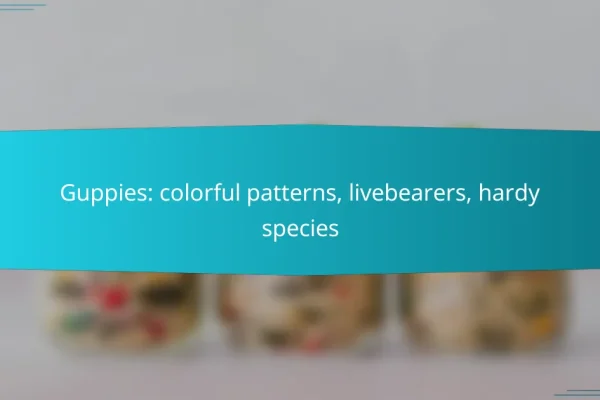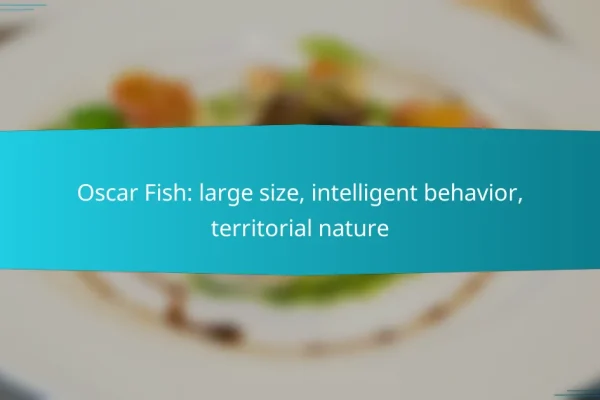What are the best aquarium fish for beginners?
The best aquarium fish for beginners are typically hardy, easy to care for, and adaptable to various water conditions. Popular choices include Betta fish, Goldfish, Neon tetras, and Zebra danios, each offering unique characteristics and care requirements.
Betta fish
Betta fish, known for their vibrant colors and flowing fins, are a great option for novice aquarists. They thrive in smaller tanks, ideally 5 gallons or more, and prefer warm water temperatures between 76°F and 82°F (24°C to 28°C).
While Betta fish can be territorial, keeping them alone or with peaceful tank mates can prevent aggression. Regular water changes and a balanced diet are essential for their health.
Goldfish
Goldfish are classic aquarium fish that can live for many years with proper care. They require a minimum tank size of 20 gallons due to their potential size and waste production, making filtration and regular maintenance crucial.
Goldfish thrive in cooler water temperatures, ideally between 65°F and 75°F (18°C to 24°C). Be mindful of their diet, as overfeeding can lead to health issues.
Neon tetra
Neon tetras are small, colorful fish that are perfect for community tanks. They prefer to be in schools of at least six, which helps reduce stress and encourages natural behaviors.
These fish do well in slightly acidic to neutral water (pH 6.0 to 7.0) and thrive at temperatures between 70°F and 81°F (21°C to 27°C). A well-planted tank with hiding spots enhances their environment.
Zebra danio
Zebra danios are hardy fish that adapt well to various water conditions, making them ideal for beginners. They are active swimmers and should be kept in groups of at least five to promote social behavior.
These fish prefer a temperature range of 64°F to 74°F (18°C to 23°C) and can tolerate a range of pH levels. They are also known for their resilience, making them less prone to common aquarium diseases.
How to choose compatible fish for your aquarium?
Choosing compatible fish for your aquarium involves understanding the needs and behaviors of different species. Compatibility is influenced by factors such as size, temperament, and social dynamics within the tank.
Community fish selection
When selecting community fish, prioritize species that thrive in groups and share similar environmental needs. Popular community fish include tetras, guppies, and rasboras, which generally coexist peacefully and prefer to be in schools of five or more.
Research the specific requirements of each species, including water temperature, pH levels, and dietary needs, to ensure a harmonious environment. Avoid mixing aggressive fish with peaceful species to prevent stress and potential harm.
Size compatibility
Size compatibility is crucial for maintaining a balanced aquarium. Larger fish can intimidate or prey on smaller species, leading to stress or fatalities. Aim for a mix where the largest fish are no more than twice the size of the smallest fish in the tank.
Consider the adult sizes of the fish you plan to keep. For example, while a small betta may seem compatible with tiny neon tetras, the betta’s territorial nature can pose risks as it matures.
Temperament matching
Matching fish temperament is essential for a peaceful aquarium. Some fish are naturally aggressive, while others are more docile. Grouping aggressive species, like cichlids, with similarly aggressive fish can reduce conflict.
Monitor the behavior of your fish regularly. If you notice signs of stress, such as hiding or fin nipping, it may be necessary to rearrange the tank or remove incompatible species. A good rule of thumb is to mix one aggressive fish with two or more peaceful ones to dilute aggression.
What are the ideal tank conditions for different fish species?
Different fish species require specific tank conditions to thrive, including appropriate water temperature, pH levels, and tank size. Understanding these requirements is crucial for maintaining a healthy aquarium environment.
Water temperature ranges
Water temperature is vital for the health of aquarium fish, with most species thriving in specific ranges. Tropical fish generally prefer temperatures between 24-28°C (75-82°F), while coldwater species can do well in cooler conditions around 18-22°C (64-72°F).
It’s essential to use a reliable aquarium heater and thermometer to maintain stable temperatures. Sudden fluctuations can stress fish and lead to health issues.
pH level requirements
The pH level of the water affects fish health and behavior, with most freshwater species preferring a pH between 6.5 and 7.5. Some species, like African cichlids, thrive in more alkaline conditions, while others, such as tetras, prefer slightly acidic water.
Regular testing with a pH kit can help you maintain the ideal levels for your fish. Adjustments can be made using pH buffers or natural methods like adding driftwood or peat moss.
Tank size recommendations
Tank size is crucial for providing adequate space for fish to swim and establish territories. A minimum of 75 liters (20 gallons) is often recommended for small community tanks, while larger species may require significantly more space.
Overcrowding can lead to stress and poor water quality, so it’s important to research the specific needs of each species. As a general rule, allow about 1 inch of fish per gallon of water, but consider the adult size of the fish when planning your aquarium.
What are the common mistakes when selecting aquarium fish?
Common mistakes when selecting aquarium fish include overcrowding the tank, ignoring the size fish will reach at maturity, and neglecting water quality. These errors can lead to stress for the fish and ultimately affect their health and lifespan.
Overcrowding the tank
Overcrowding occurs when too many fish are placed in a tank, leading to inadequate space and resources for each fish. This can result in increased aggression, stress, and poor water quality due to waste accumulation. A general rule is to allow one inch of fish per gallon of water, but this can vary based on species and their specific needs.
To avoid overcrowding, calculate the adult size of the fish you plan to keep and consider the tank’s volume. Always err on the side of caution by starting with fewer fish and gradually increasing the population as you monitor the tank’s conditions.
Ignoring fish size at maturity
Many beginners overlook the fact that fish grow larger than their initial size when purchased. Ignoring the mature size can lead to cramped conditions and increased stress. For example, a small goldfish may only be a few inches long when bought, but it can grow to over a foot in length.
Research the adult size of each species before making a purchase. This knowledge will help you choose an appropriately sized tank and prevent future complications related to space and compatibility.
Neglecting water quality
Water quality is crucial for the health of aquarium fish. Poor water conditions can lead to diseases and a shortened lifespan. Regular testing for parameters such as pH, ammonia, nitrites, and nitrates is essential to maintain a healthy environment.
Invest in a reliable water testing kit and perform regular water changes, typically 10-20% weekly, to keep the tank clean. Additionally, consider using a good filtration system to help manage waste and maintain optimal water quality for your fish.
How to set up a new aquarium for your fish?
Setting up a new aquarium involves several key steps to create a healthy environment for your fish. Proper planning and execution can help ensure the well-being of your aquatic pets.
Choosing the right filtration system
Selecting an appropriate filtration system is crucial for maintaining water quality in your aquarium. A good filter removes debris, toxins, and excess nutrients, which can harm fish. Consider factors such as tank size, fish species, and the type of filtration (mechanical, biological, or chemical) needed.
For smaller tanks (up to 20 gallons), a hang-on-back filter may suffice, while larger tanks (over 50 gallons) often benefit from canister filters. Ensure the filter’s flow rate matches your tank’s volume to avoid stressing your fish.
Adding substrate and decorations
The substrate you choose can impact both the aesthetics and health of your aquarium. Common options include gravel, sand, or specialized substrates for planted tanks. Aim for a depth of 1-2 inches for fish tanks and 2-3 inches for planted aquariums.
Incorporate decorations like rocks, plants, and hiding spots to create a natural habitat. Ensure that all materials are aquarium-safe and free from harmful chemicals. Regularly check for sharp edges that could injure your fish.
Establishing a nitrogen cycle
Establishing a nitrogen cycle is essential for creating a stable environment in your aquarium. This process involves beneficial bacteria converting harmful ammonia from fish waste into less harmful nitrites and then nitrates, which can be managed through water changes.
To start the cycle, you can add a source of ammonia, such as fish food or pure ammonia, and monitor water parameters regularly. This process typically takes 4-6 weeks. Avoid adding fish until the cycle is complete to prevent stress and potential fatalities.










